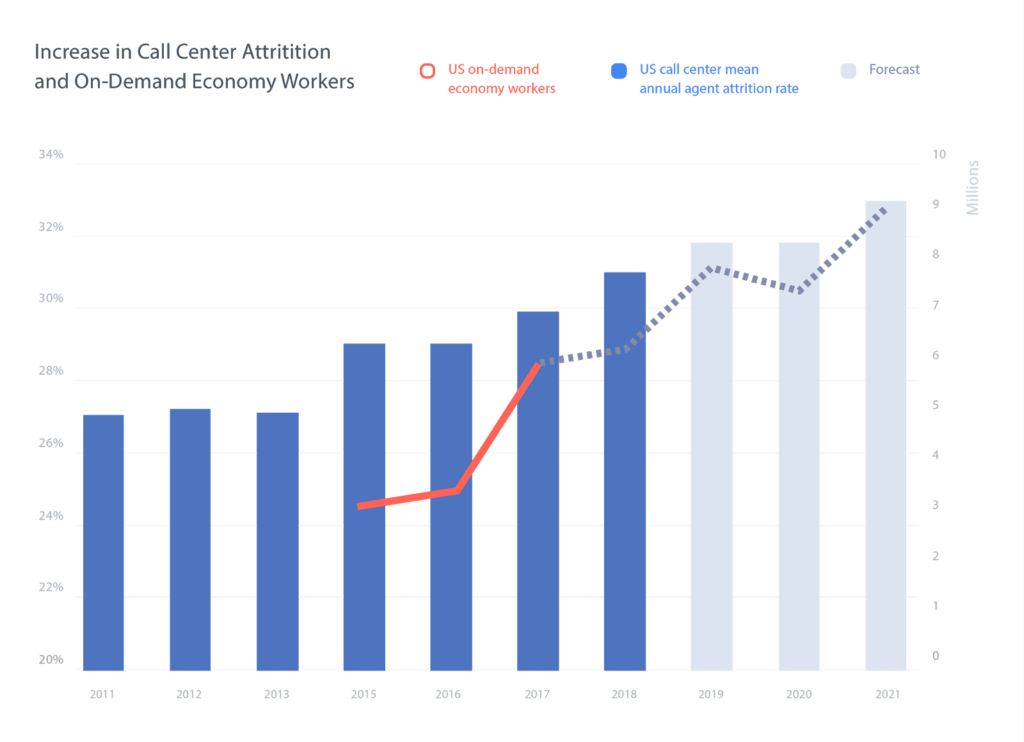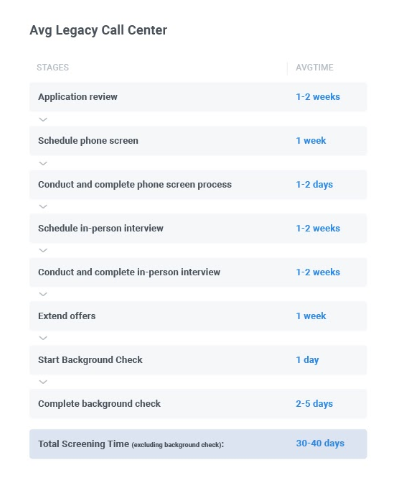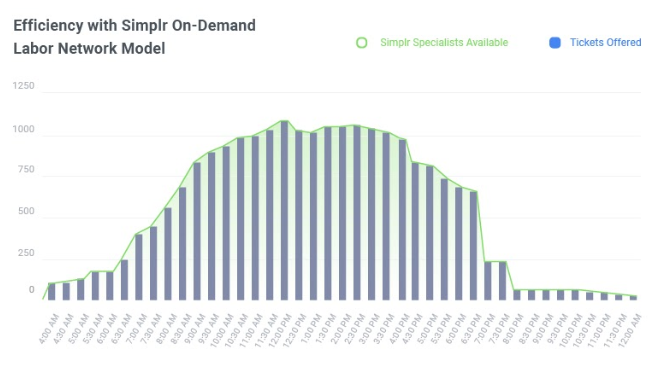3 Benefits of Staffing Your Customer Service with Gig Workers
[Updated January 25, 2022]
“In an era when pensions, unemployment benefits, and other social services are changing, many Americans view on-demand work as a way to create their own financial stability.”
Dispatches from the New Economy: The On-Demand Economy Worker Study, Intuit.
Originally coined by the former New Yorker editor Tina Brown in 2009, “gig economy” describes how workers in the knowledge economy increasingly were pursuing “a bunch of free-floating projects, consultancies, and part-time bits and pieces while they transacted in a digital marketplace.”
While gig economy-based apps such as Uber, Lyft, and TaskRabbit have contributed to the major surge in gig work, the game-changing effect of the COVID-19 pandemic has brought delivery apps like PostMates and Instacart to the forefront of on-demand work. Innovation became more important than ever. Additionally, direct-to-consumer brands and retailers are leveraging on-demand or gig workers to help staff high-quality customer experiences via email, live chat, SMS or text messaging, tech support, or a phone call.
The use of customer service gig workers in staffing online customer service departments is becoming more and more acceptable among large and enterprise online retailers. The pandemic has created a need for more scaleable customer support and less fixed costs for retailers and direct-to-consumer brands across all industries.
The macrotrend of increasing call center attrition across the legacy call center industry along with the rise of on-demand economy & online talent marketplaces-such as Lyft, Amazon Mechanical Turk, Upwork, TaskRabbit, and Airbnb-cannot be ignored. A high turnover rate does not only lead to lost sales but also a disruption in business operations.

Sources: ContactBabel, Intuit and Emergent Research. Bureau of Labor Statistics, U.S. Department of Labor,
Whether your organization is currently navigating managing remote workforces or aiming for the improvement in customer satisfaction, here are three benefits of expanding customer service with contract work to support you now and into the future as your business grows:
1. More Flexibility Means Happier Customer Service Workers
Customer care agents who work in an on-demand workforce at a company are more likely to be satisfied with their jobs. Traditional domestic call centers have always been plagued by high attrition, absenteeism, and minimum wage. These factors contribute to low morale among BPO and support agents and often impact the quality of support provided. Even a highly skilled worker will lose motivation to perform if the work culture is toxic and very stressful. The desire to leave the company can be further fueled by the fact that there are many telecommuting opportunities around.
In fact, “lack of flexibility” is one of the main reasons cited for absenteeism in legacy call centers. Unsurprisingly, significant levels of staff absence can cause major problems with contact center performance, and, ultimately, the customer experience.
Additionally, the disruption caused by the Earth’s natural disasters or the COVID-19 crisis can be devastating for workers who are unable to travel to work or whose call center has suddenly closed. This is especially apparent today for companies who rely on offshore support teams. The absences caused by these catastrophes – though no fault of the labor force itself – can wreak havoc on morale and cost a significant amount of time and money to rectify.
On the other hand, people who work in the gig economy have far more control over their work-life balance than those who are required to report for their shift at a contact center. When independent contractors in the customer service industry “come online,” they’re bringing their most optimal selves to the job. There is also less restriction on career or personal development – support team members can pursue other career opportunities or start a family while still “logging on” anytime they’d like.
Millennials comprise a huge chunk of the population in the gig economy. Although not exactly the ideal place to find their dream jobs, many are taking temporary work to pay the bills and gain financial freedom. This is not surprising as there’s an abundance of tasks available.
For example, a student can apply for a customer service job in a short term to support his or her schooling and get paid based on the task performed. A newly-graduate individual with a background in IT can submit a proposal for an Agile software development project or complete a simple workflow task to gain professional experience. A person with strong written communication skills may write blog posts, newsletter copy, product descriptions, and other content marketing materials for a logistics company or a subscription business model in an agreed amount of time. Even market research like the distribution of surveys or conducting interviews can be done by an independent contractor.
Case in point, SimplrFlex’s online platform recruits, hires, and staffs independent contractors to answer chats, emails, and social media direct messages for large and enterprise retailers. One of its Glassdoor reviews shows just how positive the experience can be for this stay-at-home parent, who would otherwise not be able to work full time in a contact center or at a company.
SimplrFlex has been so great because of the flexibility. I can log in whenever I would like. I contribute to my household income, yet I have plenty of time to raise my kids. I like the challenge each ticket gives me. I like the feeling of helping people out.
In order to be successful, customer support gig workers are expected to have the right tools, such as a laptop and reliable internet. This however is a far less burden than, say, rideshare companies, where contractors must incur the costs of purchasing a car and managing repairs and depreciation themselves.

2. Recruiting in the Gig Economy is Easier Than in Traditional Call Centers
The traditional approach of recruiting and hiring people for legacy call centers is fundamentally flawed and will only get harder as additional talent transitions to the gig economy or online talent marketplace. The very large differences in work flexibility, conditions, and CX performance are undeniable.
The COVID-19 pandemic has exacerbated this trend. Call centers typically rely on large, in-person recruiting events and group interviews to recruit people. Not to mention the close quarters the support team members work from in their day-to-day. Contact center recruitment departments often opt for group interviews in the early stages of the hiring process because, traditionally, it was most efficient to screen a high volume of applicants in a short amount of time. However, with social distancing measures in place and the future of bricks-and-mortar call centers in questions, this has become nearly impossible.
This blow to recruitment strategy indicates that call centers may not be able to recruit the best talent out there.
Companies that can provide an on-demand customer support team, however, have already mastered the art of highly-efficient and safe online recruitment. Companies that are doing it already have robust expertise in recruiting via:
- Social media ads on Facebook, Twitter, LinkedIn
- Facebook community groups for target demographics
- Online referral programs from existing contract work
Contact centers will need to make sure they completely overhaul their recruitment strategies in order to compete with the quality of workers that gig economy businesses are attracting. Streamlining the recruitment process, offering a competitive rate, and allowing flexible work schedules are only a few strategies to attract new talents and turn them into full-time workers in the future.
3. Scaling Customer Service with High-Quality Hiring
Many aspects of today’s on-demand economy are inherently digital. App-based platforms, AI-powered knowledge base tools and online collaboration software are just a few solutions that help make it easier for gig workers to learn the business and succeed in it.

This applies to hiring as well. If you’re looking to scale help by sourcing contract workers from an established outsourcer, chances are good that the hiring process is faster, more efficient, and less biased than in the traditional contact center model. Also, 100% digital.
In the past, call centers use the following, time-consuming process to make their hires:
- Application review (1-2 weeks)
- Schedule in-person or virtual interview (1 week)
- Conduct and complete interviews (1-2 weeks)
- Extend offers (1 week)
- Start background check (1 day)
- Complete background check (2-5 days)
Interviews are a good way to make a connection with people, but they are problematic in some aspects. They’re hard to schedule at scale and are vulnerable to acts of unconscious bias. With the onset of COVID-19, interviews are moved to virtual meeting spaces, including team interviews, but can still take a long time to schedule and complete. Many call centers that did not previously conduct virtual interviews have had to make the adjustment, which can cause friction in the process.
Companies that specialize in hiring gig workers for customer service usually use an all-digital process that can be completed in less than 3 days:
- Application submitted (2-6 minutes)
- Intelligent screening process (30 minutes)
- Passed intelligent screening (60 seconds)
- Complete online training and skills evaluation (2 hours)
- Start background screening (1 day)
- Cleared background screening (2 days)
A faster hiring process ensures that highly-qualified gig economy customer service workers are more readily available to start helping out on the unique customer issues in your business.
Gig Economy Workers Provide Perfect Efficient Staffing Model in Customer Service
As with Uber, Lyft, PostMates, or any other gig economy platform, you only pay for the service you get. With a car service for example, you pay for your driver to not only to drive, but also to arrive and wait. With Uber, you only pay for the actual ride, which lowers costs. Customer feedback on aggregate for these platforms is universally positive. The flexibility and scalable nature of the on-demand economy applies to the customer service industry as well. By paying workers on a per-resolution basis, you’re only staffing and paying for the work needed at your company.
Your company grows or seasonal trends create a surge of tickets and you need to scale? Great, turn up the dial! (Or rather, let the dial turn itself.) Need to cut back on your customer support team? No worries, the on-demand model is distributed among a large team and no one will get offended if scaling customer service for you means temporarily scaling downward.

How to do on-demand customer support with Simplr
With the COVID-19 crisis upending revenue forecasting, it’s more important than ever that customer service staffing is as efficient yet high-quality as possible. Staffing customer service teams with on-demand gig workers is a convenient way to ensure your company delivers quality customer service within a flexible model.
Intelligently staffing customer success is even more achievable now thanks to the rapidly increasing numbers of customer support gig workers throughout the US. This is the case even if your customer support issues are complex or you already have an in-house support team that you’d like to free up for critical projects. It is good practice to carefully plan which tasks are to be outsourced and who to hire. Effective utilization of talents can reduce overhead expenses without sacrificing excellent customer experience. Can customer service scale and can customer experience actually be improved with the help of an outside partner? If our raving customer success stories are anything to go on, we’d very much say “yes!”